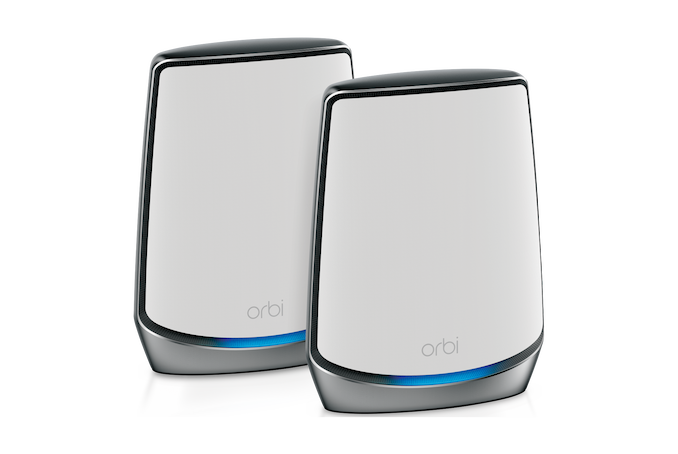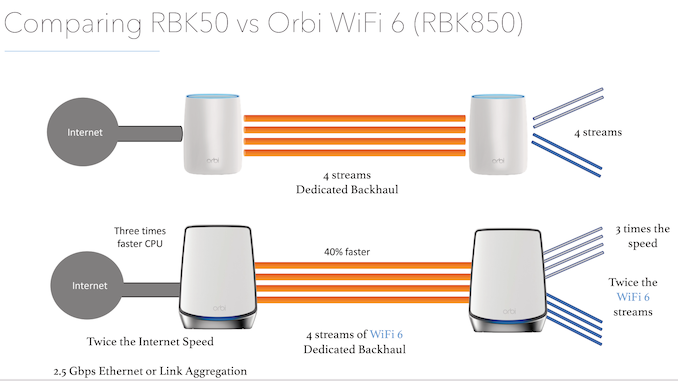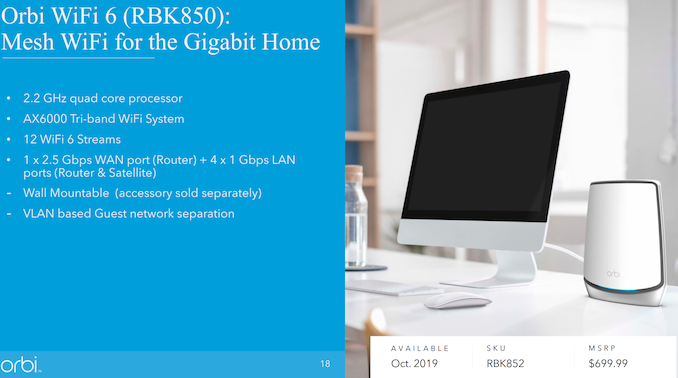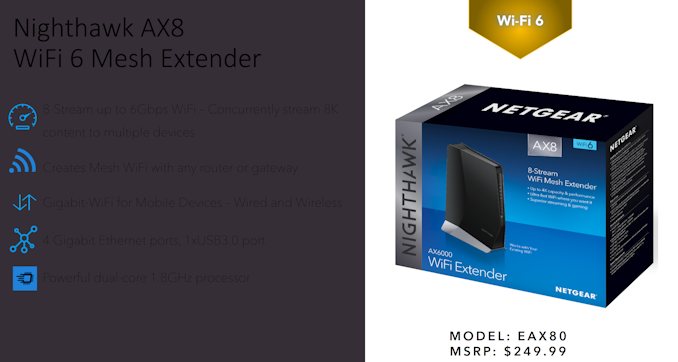Netgear Expands 802.11ax Portfolio with Orbi Wi-Fi 6 Mesh System and Nighthawk EAX80 Extender
by Ganesh T S on September 6, 2019 4:00 AM EST- Posted in
- Networking
- NetGear
- Qualcomm
- Broadcom
- Trade Shows
- 802.11ax
- Orbi
- Wi-Fi 6
- IFA 2019

As part of IFA 2019, Netgear has a number of new announcements across different product lines. The wireless networking products are of particular interest to us. We had attended Qualcomm's Wi-Fi 6 Day last month, and I had tweeted about Netgear's Orbi Wi-Fi 6 (RBK850) that was showcased at the event. Things are being made official today, with additional details becoming available.
Netgear's Orbi systems need little introduction, given their wide retail reach and popularity. At CES 2019, the company had divulged some details about the meshing together of Orbi and Wi-Fi 6. The key to the great performance of the Orbi RBK50 (802.11ac) was the dedicated 4x4 wireless backhaul between the router and the satellites. This left two 2x2 streams (one in 5 GHz and one in 2.4 GHz) available for the client devices connected to either member of the kit. The Orbi RBK850 (the kit carries the RBK852 designation) retains the same 4x4 backhaul, but makes the move from Wi-Fi 5 to Wi-Fi 6. In theoretical terms, the wireless backhaul is now 2.4 Gbps (4x4:4 / 80MHz 802.11ax) compared to 1.73 Gbps in the RBK50. The clients also get 4x4:4 streams from the satellite or the router, with one set of spatial streams dedicated to 2.4 GHz duties / 1.2 Gbps, and another to 5 GHz duties / 2.4 Gbps. Wired backhaul is also supported (the dedicated wireless backhaul spatial streams are disabled in that case), just like the Orbi RBK50.
As announced at Qualcomm's Wi-Fi 6 Day, the Orbi RBK852 is based on Qualcomm's Networking Pro 1200 platform. It will be available next month and the kit (a single router and satellite) will be priced at $700.
In other Orbi news, Netgear is announcing that the Orbi Voice and Outdoor Orbi satellites for the original Orbi (802.11ac) are getting a 'Universal Mode' update, enabling them to act as extenders for any router (even non-Netgear ones). This is a welcome addition to the Orbi family's feature set, and will help the company draw more people into the Orbi ecosystem.
Netgear is also announcing the Nighthawk EAX80 Wi-Fi 6 wireless extender today. It is based on a Broadcom chipset and meant to complement the Wi-Fi 6 routers already in the market.
Netgear is aiming to promote ease of extender use with an app-based configuration flow. The EAX80 will be available later this month for $250.
Based on reader feedback for previous Wi-Fi 6 articles, I brought up two questions for Netgear related to the above announcements - one related to the pricing of the Orbi RBK852 at $700 (a tad too high?), and another related to the consumer appetite for Wi-Fi 6 equipment given the current draft nature of the 802.11ax standard.
On the cost aspect, Netgear noted that the premium Wi-Fi 6 Nighthawk routers priced around the $300 - $400 range have been selling relatively well. Given that a mesh system is essentially the hardware for at least two wireless routers in one kit, the pricing is justified. Regarding the consumers' ability to stomach a $700 expense for a Wi-Fi system, Netgear pointed to internal surveys that showed consumers treating Orbi-like Wi-Fi systems as long-term investments (3-5 years). Given that these are folks who have invested in the latest premium notebooks and phones (Wi-Fi 6 clients), Netgear believes that the target market would not be put off by the price tag of the Orbi Wi-Fi 6 kit.
Apropos the Wi-Fi 6 standard's pending ratification, Netgear believes that the issues currently holding back Wi-Fi 6 in the draft stage are all controllable via the firmware, and will not require any hardware fixes. Since ongoing firmware updates have pretty much become the norm for most electronic products nowadays, any changes in the standard between now and eventual ratification can also make it to units already deployed in the field. It must also be noted that a final standard is needed to ensure maximum inter-operability between Wi-Fi 6 clients and APs from different vendors. Given that Netgear has systems based on silicon from all three major chipset vendors (Qualcomm, Broadcom, and Intel), interoperability issues should not be much of a concern for their customers.
Overall, we see that the Wi-Fi 6 market is poised to take off with the ongoing launch of multiple Wi-Fi 6 client systems and phones. The rollout of DOCSIS 3.1 as well as FTTH ISPs has brought gigabit Internet to many households, and consumers' appetite for practical gigabit Wi-Fi has been whetted. Netgear's 802.11ax portfolio expansion is happening at the right time for the company to take advantage of the current state of the market.
Source: Netgear

















21 Comments
View All Comments
AdditionalPylons - Friday, September 6, 2019 - link
Why 2.5 Gbps WAN port but just 1 Gbps LAN ports? I would think almost nobody in the world has internet connection faster than 1 Gbps, while a lot more people have a NAS (or high-end desktop/workstation) with 10 GbE. IEEE 802.3bz (NBASE-T and MGBASE-T) really needs to be adapted by more vendors. Prices are starting to come down but it's still a major problem.High power consumption is no longer much of a problem with newer chipsets like Aquantia.
abufrejoval - Friday, September 6, 2019 - link
+1ganeshts - Friday, September 6, 2019 - link
Apparently the 1Gbps LAN ports can be link-aggregated too, and the LAG port can be used as uplink to the modem (many DOCSIS 3.1 modems have LAG ports to connect to the router). The NBASE-T port can then be used as part of the LAN.AdditionalPylons - Friday, September 6, 2019 - link
In my experience, LAG works best to increase throughput when there are multiple concurrent users. It does not guarantee a speed-up for a single user for many protocols. For iSCSI it works quite well, but Samba multichannel still had a long way to go before becoming stable last time I checked.I would much rather have multigigabit ports than using LAG over 1 GbE ports.
Plus of coarse LAG means more cable clutter (granted, typically only short distances anyway).
abufrejoval - Friday, September 6, 2019 - link
Not sure if this helps a lot. LAG is very useful in server workloads with lots of clients using hundreds or throusands of TCP sessions.And for me it's not really about the Internet bandwidth, where I don't expect economical Gbit any time soon. For me it's about using the 10Gbit capable NBase-T core of my home lab as well as possible w/o those cables. And there it's mostly about pushing down those peak loads e.g. when you want to copy a VM or bigger project to your WLAN laptop before going to work, whilst you're having breakfast at the big table in the living room, where you don't keep cables around (kids!).
That is a big smart hybrid RAID talking to an NVMe laptop quite capable of pushing 10Gbit Ethernet speeds and I want to get as close as WiFi 6 air speed allows, so I don't have to get the 2.5Gbit USB Ethernet dongle and the extension cable.
Got the €20 WiFi 6 upgrade for the laptops, now I just want to use it properly...
name99 - Friday, September 6, 2019 - link
"LAG is very useful in server workloads with lots of clients using hundreds or throusands of TCP sessions."That's irrelevant. The point that matters for home is that a SINGLE TCP or UDP session uses a single ethernet line. So you can't connect your work computer to your NAS and copy files over twice as fast :-(
But what you CAN do is have two computers connected to the NAS, each copying over files at 1G, and they won't slow each other down.
Point is --- you don't need hundreds of sessions to see value. But you do need more than one...
The extent to which this is useful to you depends on your home setup. If you have, eg, his and hers computers, and you're both frequently interacting with a NAS, you will then see some value. But if you tend to work at different times, or each computer tends to hit the NAS only infrequently, so there's very rarely overlap in the network loads, then ...
LAG is not necessarily useless at home. But it's definitely not something I'd pay for. If the HW includes it, fine; but if you want me to pay for it feature, it damn well better be something that's actually GENERICALLY useful, like 2.5G.
abufrejoval - Sunday, September 8, 2019 - link
pretty much what I said, too...Amit_NTGR - Monday, September 9, 2019 - link
A bit of a clarification. The Orbi WiFi 6 Router comes with 5 ports (1 x 2.5 Gbps WAN and 4 x 1 Gbps LAN). There are several Cable Modems (eg. CM1150v, CM1200) that have LAG capabilities on the LAN side, and we're trying to provide deployment flexibility to get to multi-gigabit speeds on the Orbi.Jedi2155 - Friday, September 13, 2019 - link
Just because there aren't common 1 gbps+ residential internet speeds today, doesn't mean they won't exist before the AX standard is replaced. Historically, each of the recent wireless generations has lasted around 7 years (2005 n, 2012 ac, 2019 ax). So there might use for the 2.5 gbps WAN port in the future before WiFi 6 becomes obsolete.brantron - Friday, September 6, 2019 - link
"Negear"Really? Do you even look at the site after articles go through alleged editors?